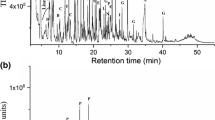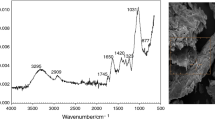Abstract
Slow pyrolysis experiments were performed at 500 °C on Russian feedstock (hydrolysis lignin, peat, mixed sewage sludge, and pine and spruce woods, for comparison). The pyrolysis products were analyzed through gas chromatography, and more than 130 components were identified and grouped according to their chemical family. A qualitative analysis of the pyrolysis products showed that the highest amount of molecules (more than 40%) released during the pyrolysis of hydrolysis lignin belongs to the phenol chemical family. They result from the lignin degradation. The peat pyrolysis led to a large amount (more than 50%) of sugars. The molecules detected during the pyrolysis of the mixed sewage sludge are similar to that of the spruce sample and almost the same as that of the pine sample, because the selected sewage sludge is a mixture of municipal and industrial waste from pulp and paper industry. Comparisons between the data obtained for these Russian feedstock and that of the literature concerning quite similar materials exhibit differences which may be the consequence of the feedstock and of the experimental conditions.

Similar content being viewed by others
References
Rabinovich ML, Fedoryak O, Dobele G, Andersone A, Gawdzik B, Lindström ME, Sevastyanova O. Carbon adsorbents from industrial hydrolysis lignin: the USSR/Eastern European experience and its importance for modern biorefineries. Renew Sustain Energy Rev. 2016;57:1008–24. https://doi.org/10.1016/j.rser.2015.12.206.
Ragg PL, Fields PR. The development of a process for the hydrolysis of lignocellulosic waste. Philos Trans R Soc Lond A. 1987;321:537–47. https://doi.org/10.1098/rsta.1987.0030.
Wang Z. Bergius process. In: Wang Z, editor. Comprehensive organic name reactions and reagents. Hoboken, NJ: Wiley; 2010. p. conrr074. https://doi.org/10.1002/9780470638859.conrr074.
Schlesinger WH, Bernhardt E. The global cycles of sulfur and mercury. In: Schlesinger WH, Schlesinger WH, editors. Biogeochemistry: an analysis of global change. 3rd ed. Cambridge: Academic Press; 2013. p. 469–86.
Beith R, Liu H. Biomass fuels for small and micro combined heat and power (CHP) systems: resources, conversion and applications. In: Beith R, editor. Small and micro combined heat and power (CHP) systems: advanced design, performance, materials and applications. Cambridge: Woodhead Pub. Ltd; 2011.
Manara P, Zabaniotou A. Towards sewage sludge based biofuels via thermochemical conversion—a review. Renew Sustain Energy Rev. 2012;16:2566–82. https://doi.org/10.1016/j.rser.2012.01.074.
Schnell M, Horst T, Quicker P. Thermal treatment of sewage sludge in Germany: a review. J Environ Manage. 2020;263: 110367. https://doi.org/10.1016/j.jenvman.2020.110367.
Glińska K, Ismail MSB, Goma-Camps J, Valencia P, Stüber F, Giralt J, Fabregat A, Torrens E, Olkiewicz M, Bengoa C. Recovery and characterisation of cellulose from industrial paper mill sludge using tetrakis and imidazolium based ionic liquids. Ind Crops Prod. 2019;139: 111556. https://doi.org/10.1016/j.indcrop.2019.111556.
Glińska K, Lerigoleur C, Giralt J, Torrens E, Bengoa C. Valorization of cellulose recovered from WWTP sludge to added value levulinic acid with a Brønsted acidic ionic liquid. Catalysts. 2020;10:1004. https://doi.org/10.3390/catal10091004.
Fan H, Zhou H, Wang J. Pyrolysis of municipal sewage sludges in a slowly heating and gas sweeping fixed-bed reactor. Energy Convers Manage. 2014;88:1151–8. https://doi.org/10.1016/j.enconman.2014.05.043.
Fonts I, Gea G, Azuara M, Ábrego J, Arauzo J. Sewage sludge pyrolysis for liquid production: a review. Renew Sustain Energy Rev. 2012;16:2781–805. https://doi.org/10.1016/j.rser.2012.02.070.
Gao N, Kamran K, Quan C, Williams PT. Thermochemical conversion of sewage sludge: a critical review. Prog Energy Combust Sci. 2020;79: 100843. https://doi.org/10.1016/j.pecs.2020.100843.
Magdziarz A, Werle S. Analysis of the combustion and pyrolysis of dried sewage sludge by TGA and MS. Waste Manage. 2014;34:174–9. https://doi.org/10.1016/j.wasman.2013.10.033.
del Río JC, Gutiérrez A, Martínez MJ, Martínez AT. Py–GC/MS study of Eucalyptus globulus wood treated with different fungi. J Anal Appl Pyrolysis. 2001;58–59:441–52. https://doi.org/10.1016/S0165-2370(00)00184-4.
Ohra-aho T, Tenkanen M, Tamminen T. Direct analysis of lignin and lignin-like components from softwood kraft pulp by Py–GC/MS techniques. J Anal Appl Pyrol. 2005;74:123–8. https://doi.org/10.1016/j.jaap.2004.11.010.
Chen W-H, Wang C-W, Kumar G, Rousset P, Hsieh T-H. Effect of torrefaction pretreatment on the pyrolysis of rubber wood sawdust analyzed by Py–GC/MS. Biores Technol. 2018;259:469–73. https://doi.org/10.1016/j.biortech.2018.03.033.
Chen L, Wang X, Yang H, Lu Q, Li D, Yang Q, Chen H. Study on pyrolysis behaviors of non-woody lignins with TG–FTIR and Py–GC/MS. J Anal Appl Pyrol. 2015;113:499–507. https://doi.org/10.1016/j.jaap.2015.03.018.
Liang F, Wang R, Hongzhong X, Yang X, Zhang T, Hu W, Mi B, Liu Z. Investigating pyrolysis characteristics of moso bamboo through TG–FTIR and Py–GC/MS. Bioresour Technol. 2018;256:53–60. https://doi.org/10.1016/j.biortech.2018.01.140.
Hidayat S, AbuBakar MS, Yang Y, Phusunti N, Bridgwater AV. Characterisation and Py–GC/MS analysis of Imperata cylindrica as potential biomass for bio-oil production in Brunei Darussalam. J Anal Appl Pyrolysis. 2018;134:510–9. https://doi.org/10.1016/j.jaap.2018.07.018.
Vyazovkin S, Sbirrazzuoli N. Isoconversional kinetic analysis of thermally stimulated processes in polymers. Macromol Rapid Commun. 2006;27:1515–32. https://doi.org/10.1002/marc.200600404.
Ponder GR, Richards GN, Stevenson TT. Influence of linkage position and orientation in pyrolysis of polysaccharides: a study of several glucans. J Anal Appl Pyrol. 1992;22:217–29. https://doi.org/10.1016/0165-2370(92)85015-D.
Paine JB, Pithawalla YB, Naworal JD. Carbohydrate pyrolysis mechanisms from isotopic labeling. J Anal Appl Pyrol. 2008;83:37–63. https://doi.org/10.1016/j.jaap.2008.05.008.
Shen DK, Gu S, Bridgwater AV. The thermal performance of the polysaccharides extracted from hardwood: cellulose and hemicellulose. Carbohyd Polym. 2010;82:39–45. https://doi.org/10.1016/j.carbpol.2010.04.018.
Patwardhan PR, Brown RC, Shanks BH. Product distribution from the fast pyrolysis of hemicellulose. Chemsuschem. 2011;4:636–43. https://doi.org/10.1002/cssc.201000425.
Liu C, Wang H, Karim AM, Sun J, Wang Y. Catalytic fast pyrolysis of lignocellulosic biomass. Chem Soc Rev. 2014;43:7594–623. https://doi.org/10.1039/C3CS60414D.
Stefanidis SD, Kalogiannis KG, Iliopoulou EF, Michailof CM, Pilavachi PA, Lappas AA. A study of lignocellulosic biomass pyrolysis via the pyrolysis of cellulose, hemicellulose and lignin. J Anal Appl Pyrol. 2014;105:143–50. https://doi.org/10.1016/j.jaap.2013.10.013.
Shen Q, Fu Z, Li R, Wu Y. A study on the pyrolysis mechanism of a β-O-4 lignin dimer model compound using DFT combined with Py–GC/MS. J Therm Anal Calorim. 2020. https://doi.org/10.1007/s10973-020-10130-1.
Carlson TR, Jae J, Lin Y-C, Tompsett GA, Huber GW. Catalytic fast pyrolysis of glucose with HZSM-5: the combined homogeneous and heterogeneous reactions. J Catal. 2010;270:110–24. https://doi.org/10.1016/j.jcat.2009.12.013.
Cheng Y-T, Huber GW. Chemistry of Furan conversion into aromatics and olefins over HZSM-5: a model biomass conversion reaction. ACS Catal. 2011;1:611–28. https://doi.org/10.1021/cs200103j.
Wang K, Kim KH, Brown RC. Catalytic pyrolysis of individual components of lignocellulosic biomass. Green Chem. 2014;16:727–35. https://doi.org/10.1039/C3GC41288A.
Zádorová T, Skála J, Žížala D, Vaněk A, Penížek V. Harmonization of a large-scale national soil database with the World Reference Base for Soil Resources 2014. Geoderma. 2021;384: 114819. https://doi.org/10.1016/j.geoderma.2020.114819.
Phyllis2—wood, pine (#787). (n.d.). https://phyllis.nl/Biomass/View/787. Accessed 16 March 2021.
Phyllis2—wood, spruce (#2402). (n.d.). https://phyllis.nl/Biomass/View/2402. Accessed 16 March 2021.
Phyllis2—peat moss (#2551). (n.d.). https://phyllis.nl/Biomass/View/2551. Accessed 16 March 2021.
Phyllis2—wood, spruce (#176). (n.d.). https://phyllis.nl/Biomass/View/176. Accessed 16 March 2021.
Phyllis2—peat (#1407). (n.d.). https://phyllis.nl/Biomass/View/1407. Accessed 16 March 2021.
Phyllis2 - paper sludge (#915). (n.d.). https://phyllis.nl/Biomass/View/915. Accessed 16 March 2021.
Phyllis2—paper sludge (#916). (n.d.). https://phyllis.nl/Biomass/View/916. Accessed 16 March 2021.
Phyllis2—sewage sludge (#1170). (n.d.). https://phyllis.nl/Biomass/View/1170. Accessed 16 March 2021.
Phyllis 1800. Wood spruce, Phyllis2 Database. (n.d.). https://www.ecn.nl/phyllis2/Biomass/View/1800.
Carrott PJM, Suhas MMLR, Carrott CI, Guerrero LA. Delgado, Reactivity and porosity development during pyrolysis and physical activation in CO2 or steam of kraft and hydrolytic lignins. J Anal Appl Pyrol. 2008;82:264–71. https://doi.org/10.1016/j.jaap.2008.04.004.
Van Krevelen DW, Te Nijenhuis K. Properties of polymers their correlation with chemical structure; their numerical estimation and prediction from additive group contributions. Amsterdam: Elsevier Science & Technology Books. 2009. http://international.scholarvox.com/book/88812025. Accessed 7 Aug 2020.
Björnbom E, Björnbom P, Karlsson O. Effect of the raw material on the liquefaction of wet peat with carbon monoxide. Fuel Process Technol. 1988;17:263–76. https://doi.org/10.1016/0378-3820(88)90039-2.
Phyllis2—paper sludge (#2746). (n.d.). https://phyllis.nl/Biomass/View/2746. Accessed 16 March 2021.
Levesque M, Dinel H. Applicability of thermal methods for characterization of peats and plants. Geoderma. 1978;20:201–13. https://doi.org/10.1016/0016-7061(78)90010-1.
Hatcher P, Lerchiii H, Kotra R, Verheyen T. Pyrolysis g.c.–m.s. of a series of degraded woods and coalified logs that increase in rank from peat to subbituminous coal. Fuel. 1988;67:1069–75. https://doi.org/10.1016/0016-2361(88)90372-9.
Orem WH, Neuzil SG, Lerch HE, Cecil CB. Experimental early-stage coalification of a peat sample and a peatified wood sample from Indonesia. Org Geochem. 1996;24:111–25. https://doi.org/10.1016/0146-6380(96)00012-5.
Godin B, Ghysel F, Agneessens R, Schmit T, Gofflot S, Lamaudière S, Sinnaeve G, Goffart J-P, Gerin PA, Stilmant D, Delcarte J. Détermination de la cellulose, des hémicelluloses, de la lignine et des cendres dans diverses cultures lignocellulosiques dédiées à la production de bioéthanol de deuxième génération. Biotechnol Agron Soc Environ. 2010;14:549–60.
Ralph J, Hatfield RD. Pyrolysis–GC–MS characterization of forage materials. J Agric Food Chem. 1991;39:1426–37. https://doi.org/10.1021/jf00008a014.
Wheeler EA. Methods in lignin chemistry. SY Lin’CW Dence (eds.), 578 pp., illus., 1992. Springer Series in Wood Science. Springer Verlag, Berlin, Heidelberg, etc. ISBN 3-540-50295-5. Price DM 480.00 (hardcover). IAWA J. 1993;14:152. https://doi.org/10.1163/22941932-90001308.
Maryandyshev P, Chernov A, Lyubov V, Trouvé G, Brillard A, Brilhac J-F. Investigation of thermal degradation of different wood-based biofuels of the northwest region of the Russian Federation. J Therm Anal Calorim. 2015;122:963–73. https://doi.org/10.1007/s10973-015-4798-3.
Wang K, Masiol M, Thimmaiah D, Zhang Y, Hopke PK. Performance evaluation of two 25 kW residential wood pellet boiler heating systems. Energy Fuels. 2017;31:12174–82. https://doi.org/10.1021/acs.energyfuels.7b01868.
Hosoya T, Kawamoto H, Saka S. Solid/liquid- and vapor-phase interactions between cellulose- and lignin-derived pyrolysis products. J Anal Appl Pyrol. 2009;85:237–46. https://doi.org/10.1016/j.jaap.2008.11.028.
Windt M, Meier D, Marsman JH, Heeres HJ, de Koning S. Micro-pyrolysis of technical lignins in a new modular rig and product analysis by GC–MS/FID and GC×GC–TOFMS/FID. J Anal Appl Pyrol. 2009;85:38–46. https://doi.org/10.1016/j.jaap.2008.11.011.
Heigenmoser A, Liebner F, Windeisen E, Richter K. Investigation of thermally treated beech (Fagus sylvatica) and spruce (Picea abies) by means of multifunctional analytical pyrolysis–GC/MS. J Anal Appl Pyrol. 2013;100:117–26. https://doi.org/10.1016/j.jaap.2012.12.005.
Hilbers TJ, Wang Z, Pecha B, Westerhof RJM, Kersten SRA, Pelaez-Samaniego MR, Garcia-Perez M. Cellulose–lignin interactions during slow and fast pyrolysis. J Anal Appl Pyrol. 2015;114:197–207. https://doi.org/10.1016/j.jaap.2015.05.020.
Kim J, Kim K-H, Kwon EE. Enhanced thermal cracking of VOCs evolved from the thermal degradation of lignin using CO 2. Energy. 2016;100:51–7. https://doi.org/10.1016/j.energy.2016.01.075.
Lee J, Yang X, Song H, Ok YS, Kwon EE. Effects of carbon dioxide on pyrolysis of peat. Energy. 2017;120:929–36. https://doi.org/10.1016/j.energy.2016.11.143.
Xin X, Pang S, de MiguelMercader F, Torr KM. The effect of biomass pretreatment on catalytic pyrolysis products of pine wood by Py–GC/MS and principal component analysis. J Anal Appl Pyrolysis. 2019;138:145–53. https://doi.org/10.1016/j.jaap.2018.12.018.
Durig JR, Calvert GD, Esterle JS. Development of a pyrolysis–gas chromatographic–Fourier transform infrared spectroscopic technique for the study of woody peats. J Anal Appl Pyrol. 1989;14:295–308. https://doi.org/10.1016/0165-2370(89)80005-1.
Calvert GD, Esterle JS, Durig JR. Pyrolysis-gas chromatography/mass spectrometry and pyrolysis–gas chromatography/Fourier transform infrared/flame ionization detection studies of particle size fractions of woody peat. J Anal Appl Pyrol. 1989;16:5–25. https://doi.org/10.1016/0165-2370(89)80032-4.
Cai W, Liu Q, Shen D, Wang J. Py–GC/MS analysis on product distribution of two-staged biomass pyrolysis. J Anal Appl Pyrol. 2019;138:62–9. https://doi.org/10.1016/j.jaap.2018.12.007.
Zhou P, Xiong S, Zhang Y, Jiang H, Chi Y, Li L. Study on the nitrogen transformation during the primary pyrolysis of sewage sludge by Py–GC/MS and Py–FTIR. Int J Hydrogen Energy. 2017;42:18181–8. https://doi.org/10.1016/j.ijhydene.2017.04.144.
Zuo W, Jin B, Huang Y, Sun Y. Thermal decomposition of three kinds of sludge by TG–MS and PY–GC/MS. J Therm Anal Calorim. 2015;121:1297–307. https://doi.org/10.1007/s10973-015-4651-8.
Wang S, Wen Y, Hammarström H, Jönsson PG, Yang W. Pyrolysis behaviour, kinetics and thermodynamic data of hydrothermal carbonization—treated pulp and paper mill sludge. Renew Energy. 2021;177:1282–92. https://doi.org/10.1016/j.renene.2021.06.027.
Acknowledgements
The authors thank M. Maugué, LGRE Mulhouse, for his technical assistance during the experiments.
Author information
Authors and Affiliations
Corresponding author
Additional information
Publisher's Note
Springer Nature remains neutral with regard to jurisdictional claims in published maps and institutional affiliations.
Rights and permissions
About this article
Cite this article
Maryandyshev, P., Kangash, A., Trouve, G. et al. Analysis through gas chromatography of the products obtained from slow pyrolysis applied to Russian feedstock. J Therm Anal Calorim 147, 8485–8498 (2022). https://doi.org/10.1007/s10973-021-11152-z
Received:
Accepted:
Published:
Issue Date:
DOI: https://doi.org/10.1007/s10973-021-11152-z





